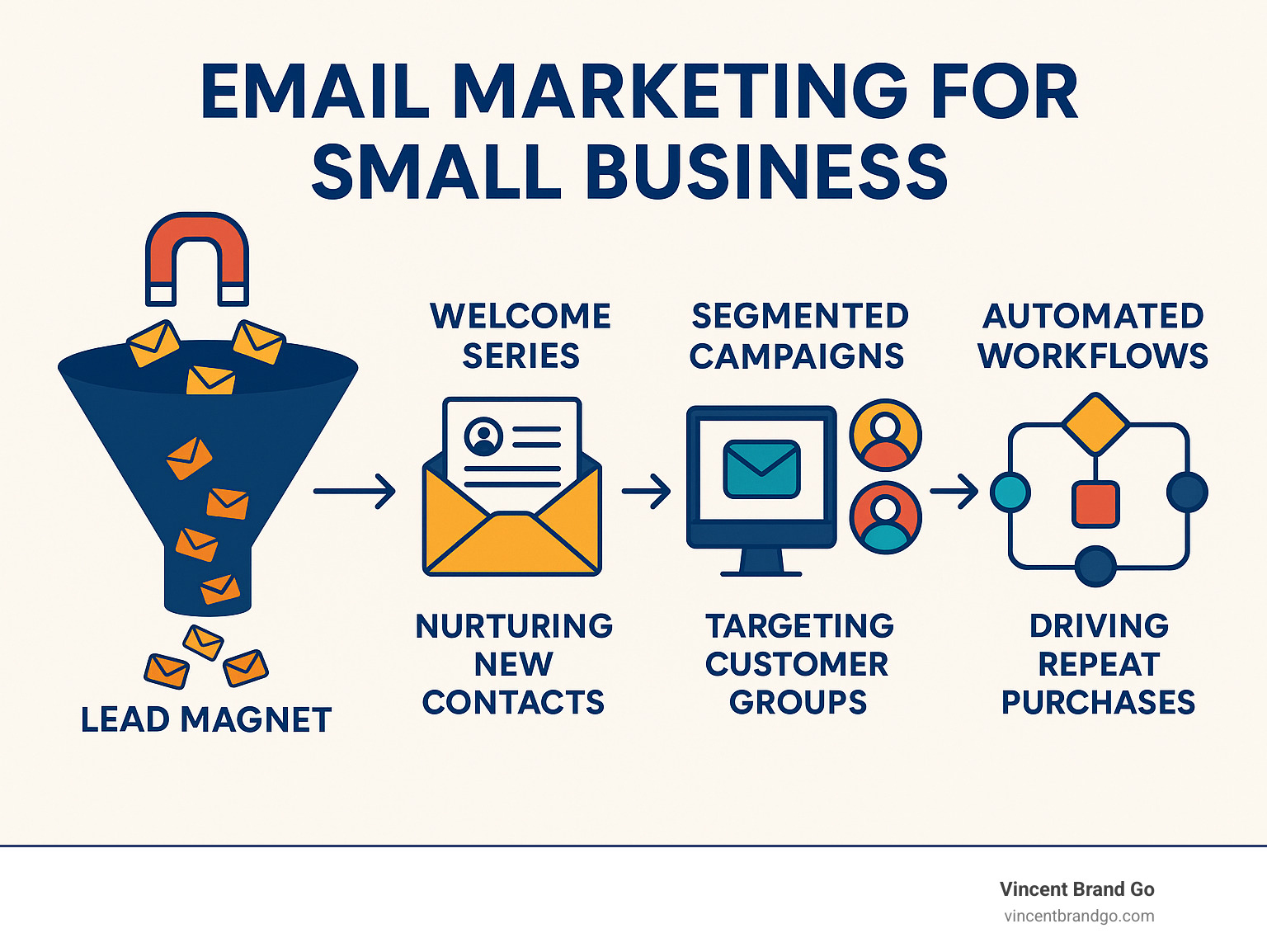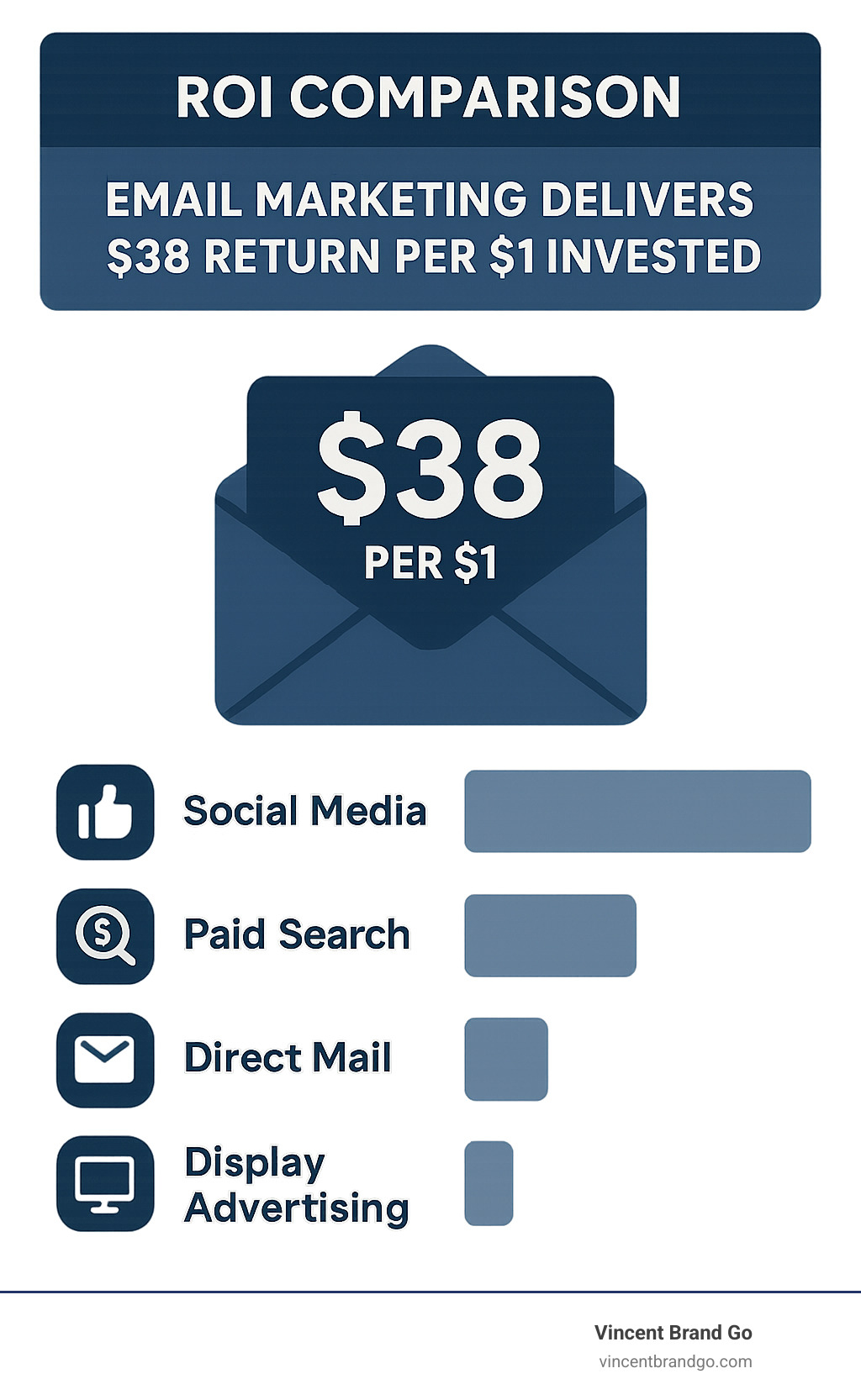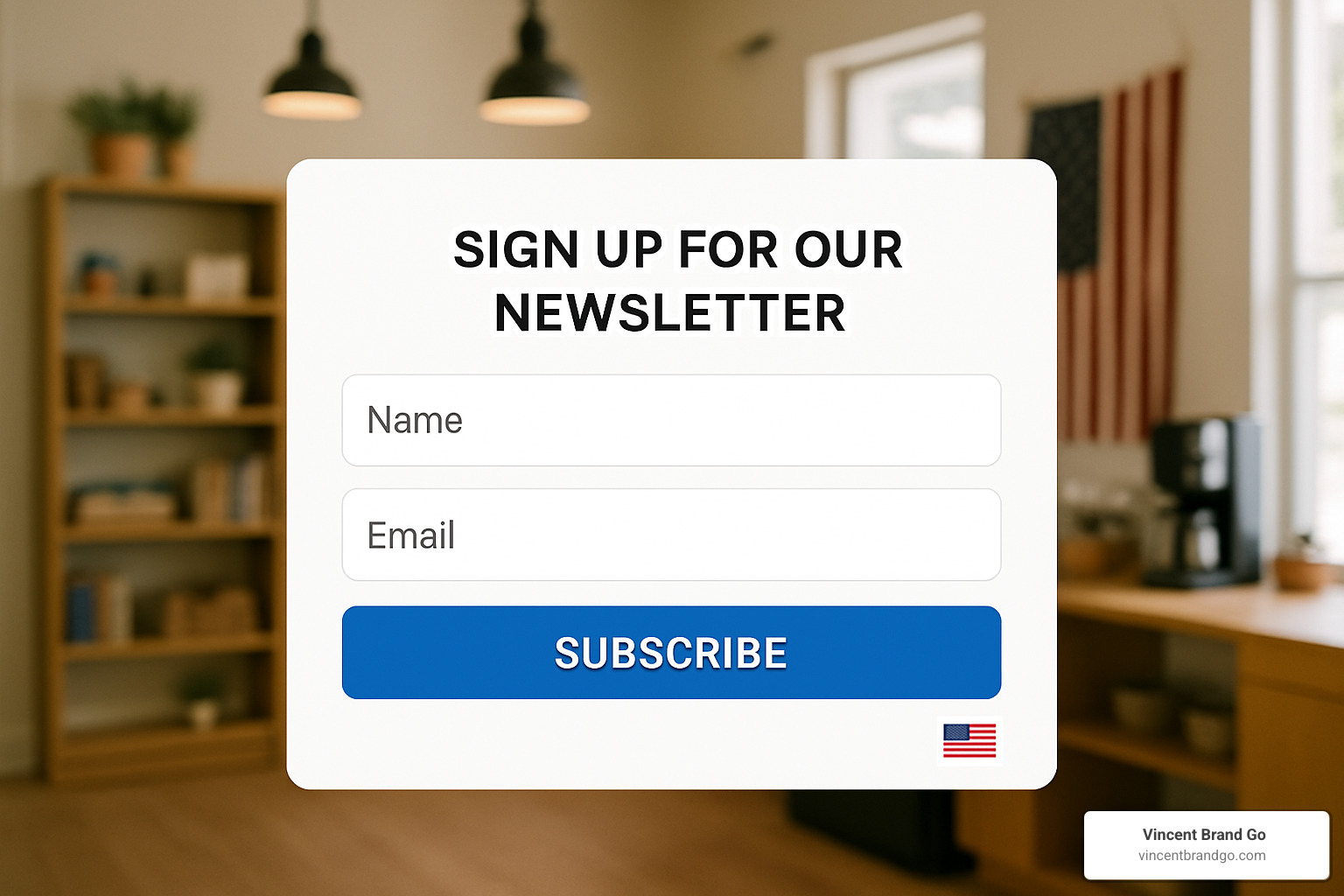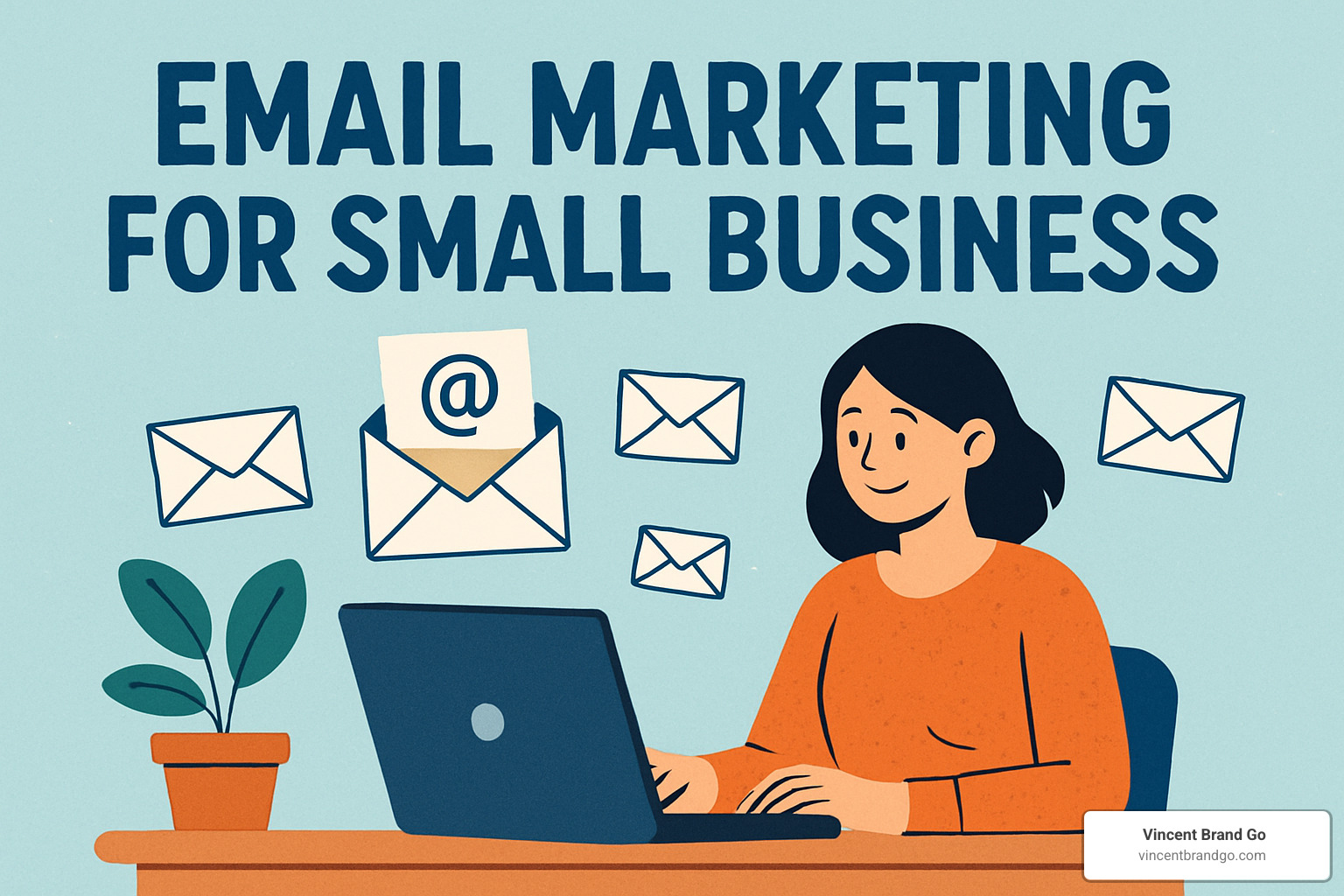Why Email Marketing for Small Business Delivers Best ROI
Email marketing for small business remains one of the most powerful tools for growth, delivering an average return of $38 for every $1 spent. Here’s what you need to know:
Key Email Marketing Basics:
– ROI: Average return of $38 per $1 invested
– Control: You own your email list (unlike social media)
– Cost: Starts free, scales affordably
– Results: Drives both new customers and repeat sales
Essential Steps to Get Started:
1. Build your email list with signup forms and lead magnets
2. Choose an email platform (many offer free tiers)
3. Create welcome emails and basic automation
4. Send regular newsletters and promotional campaigns
5. Track open rates, clicks, and sales
The numbers don’t lie. While 64% of consumers feel overwhelmed by brand communications, 49% still want weekly promotional emails from brands they love. This creates a massive opportunity for small businesses who can cut through the noise with targeted, valuable content.
Unlike social media where algorithms control who sees your content, email puts you directly in your customers’ inboxes. It’s permission-based marketing at its finest – people choose to hear from you.
I’m Jason Duncan, and I’ve spent over 20 years helping Austin businesses master digital marketing strategies that actually work. Through my experience with email marketing for small business campaigns, I’ve seen how the right approach can transform a struggling business into a thriving one.

Key terms for email marketing for small business:
– email marketing for events
– personalized promotional emails
Email Marketing for Small Business: Why & ROI
Let me share something that might surprise you: while big corporations spend millions on flashy advertising campaigns, email marketing for small business quietly delivers the most impressive returns in digital marketing. We’re talking about $38 back for every dollar you invest – and that’s not a typo.
Here’s what makes this even more remarkable: you’re reaching people who actually want to hear from you. Unlike cold calling or interrupting someone’s day with ads, email connects you with folks who raised their hand and said “yes, I’m interested in what you have to offer.”
With 4 billion email users worldwide, you’re tapping into a massive audience that checks their inbox daily. But here’s the kicker – it’s not just about reaching people. It’s about reaching them when they’re in the right mindset to engage with your message.
The beauty of email marketing for small business lies in its simplicity and affordability. You don’t need a massive budget or a team of specialists to get started. Many platforms offer free tiers that let you build your list and start connecting with customers right away.
The Power Numbers You Can’t Ignore
99% of people check their email every single day – think about that for a moment. Your customers are already in their inbox, actively looking for messages. You just need to be there with something valuable to share.
The conversion numbers are equally impressive. 66% of customers make online purchases directly because of email marketing. That’s not just browsing or considering – that’s actual money changing hands because of an email someone received.
Here’s my favorite stat: personalized subject lines boost open rates by 26%. Something as simple as including someone’s name or referencing their past purchase can dramatically improve your results.
According to Gartner’s latest email marketing benchmarks, while consumers feel overwhelmed by brand communications, 49% still want weekly promotional emails from brands they love.

Relationship Engine vs. Social Algorithms
Here’s where email marketing becomes your secret weapon against the chaos of social media. You know that sinking feeling when your Facebook post gets three likes instead of the usual thirty? That’s algorithms deciding your content isn’t worth showing to your own followers.
Email cuts through all that noise. When you send an email, it lands directly in your subscriber’s inbox. No algorithm stands between you and your message. No platform can suddenly change the rules and tank your reach overnight.
Think of your email list as your own personal audience that you actually control. If Instagram disappeared tomorrow, your email subscribers would still be there, ready to hear from you.
The intimacy factor is huge too. Reading an email feels personal, like getting a letter from a friend. Social media posts get lost in endless feeds, but emails demand attention and create moments of one-on-one connection that build stronger customer loyalty over time.
Build and Grow Your Email List
Think of your email list as a garden. You can’t just plant seeds and hope they grow – you need the right soil, regular watering, and careful tending. The same goes for building your subscriber base.

Your email list isn’t just a collection of addresses – it’s your most valuable digital asset. Unlike social media followers who might see your posts (if the algorithm allows it), your email subscribers have given you permission to land directly in their inbox.
The secret to successful email marketing for small business list building lies in making it ridiculously easy for people to join while giving them compelling reasons to do so. Start by placing signup forms in obvious spots: your website header, footer, and sidebar. Every interaction with your business should be a potential list-building moment.
For a complete breakdown of how email fits into your overall marketing strategy, check out our Digital Marketing Services for Small Business guide.
Lead Magnets That Attract the Right People
Here’s the truth: nobody wakes up excited to join another email list. But they do wake up wanting solutions to their problems. That’s where lead magnets come in – they’re the bridge between someone’s immediate need and your email list.
A great lead magnet solves a specific problem for your ideal customer. Discount codes work beautifully for retail businesses because they provide immediate value and encourage that first purchase. Checklists are perfect for service businesses – they give quick wins while showcasing your expertise.
Free guides or ebooks work when you have complex solutions to share. A wedding planner might offer “The Ultimate Wedding Timeline Checklist,” while a fitness coach could provide “5 Workouts You Can Do in Your Living Room.”
Quizzes have become incredibly popular because they’re interactive and provide personalized results. “What’s Your Marketing Personality?” or “Which Website Platform Is Right for Your Business?” can generate hundreds of subscribers while giving you valuable insights about your audience.
The magic formula is simple: make your lead magnet specific, immediately useful, and directly related to what you sell.
Opt-In Best Practices & Compliance
Building your list the right way from the start saves you headaches later and keeps your emails out of the spam folder. This isn’t just about following rules – it’s about building genuine relationships.
Double opt-in might seem like an extra step that reduces signups, but it’s actually your best friend. When someone confirms their email address, you know they’re genuinely interested. These confirmed subscribers open emails more often, click more links, and complain less about spam.
Be crystal clear about what people are signing up for. Instead of vague promises like “stay updated,” tell them exactly what they’ll get: “Get our weekly newsletter with 3 marketing tips, delivered every Tuesday morning.”
GDPR and CAN-SPAM compliance aren’t just legal requirements – they’re good business practices. Include your business address in every email, use honest subject lines, and respect people’s privacy choices.
Offline & Cross-Channel Tactics
Don’t forget about the real world when building your email list. Some of your most engaged subscribers might come from face-to-face interactions.
If you have a physical location, a simple in-store clipboard at checkout can capture emails from your happiest customers. QR codes bridge the gap between offline and online beautifully. Put them on receipts, business cards, or table tents.
Your social media bios should always include your email signup link. When someone finds you on Instagram or Facebook and wants to learn more, make it obvious how they can stay connected.
Events and trade shows are goldmines for list building. Offer something valuable: a free resource, contest entry, or exclusive event invitation. Make signing up feel like they’re getting access to something special, not just adding to their inbox clutter.
Create, Automate & Optimize Campaigns
Now comes the exciting part – turning your email subscribers into loyal customers and repeat buyers. Creating campaigns that actually drive results isn’t about sending more emails; it’s about sending the right emails to the right people at the right time.

The good news? You don’t need to be a designer or programmer to create professional-looking emails. Modern email platforms offer drag-and-drop builders that make it simple to create stunning campaigns.
Success in email marketing for small business comes from understanding your customers’ needs, timing your messages perfectly, and constantly improving based on what the data tells you.
Types of Emails That Drive Results
Think of your email campaigns like a conversation with a good friend. The best email marketers use different types of emails for different purposes, creating a natural rhythm that keeps subscribers engaged.
Welcome series emails are your golden opportunity to make a great first impression. These automated sequences introduce new subscribers to your brand and often achieve the highest open rates you’ll ever see. I recommend a 3-5 email series that shares your story and guides people toward their first purchase.
Newsletter emails keep your brand top-of-mind between purchases. Share industry insights, behind-the-scenes stories, customer spotlights, or helpful tips. The goal is to be so useful that people look forward to hearing from you.
Promotional emails are your direct sales messages, but they need to be balanced with value-driven content. When you do send promotions, make them feel special with limited-time offers or exclusive discounts for email subscribers.
Abandoned cart emails are absolute gold for e-commerce businesses. These automated messages remind customers about items they left behind and typically recover 10-15% of abandoned purchases.
Re-engagement campaigns help you win back subscribers who’ve gone quiet. Instead of just removing inactive people, try sending them your best content or a special “we miss you” offer.
For businesses wanting to take their promotional campaigns to the next level, our Personalized Promotional Emails service can help create campaigns that feel individually crafted for each subscriber.
Segmentation Strategies for Email Marketing for Small Business
Sending the same email to everyone on your list is like using a megaphone when you should be having individual conversations. Email marketing for small business becomes dramatically more effective when you segment your audience and send targeted messages.
Start with simple segmentation based on purchase history. Customers who’ve bought from you before need different messages than first-time visitors. They already trust you, so you can focus on introducing new products or rewarding loyalty.
Geographic segmentation works wonders for local businesses. A restaurant can send different promotions to people within delivery range versus those who need to drive in.
Engagement level segmentation helps you treat your most active subscribers like VIPs. People who open every email deserve your best offers and exclusive content. Meanwhile, less engaged subscribers might need more value-driven content to rebuild interest.
Automation Essentials for Email Marketing for Small Business
Automation is where email marketing transforms from a time-consuming task into a revenue-generating machine that works while you sleep. The secret is setting up workflows that respond to what your subscribers actually do.
Your welcome flow should be the first automation you set up. When someone joins your list, they’re most interested in hearing from you right then. Set up a sequence that welcomes them, shares your story, and showcases your best offerings.
Abandoned cart flows are like having a gentle, persistent salesperson who never gets tired. The first email goes out after an hour with a simple reminder. The second email addresses common concerns. The third email creates urgency with a limited-time discount.
Post-purchase flows turn one-time buyers into repeat customers. Thank them for their purchase, provide tracking information, share usage tips, ask for a review, and recommend complementary items.
The difference between manual campaigns and automated workflows is like the difference between remembering to water your plants and having an irrigation system.
Copy, Design & Mobile UX Tips
Great email marketing feels effortless to the reader, but that simplicity comes from careful attention to both words and design. Since more than half of all emails are opened on mobile devices, everything you create needs to work perfectly on a small screen.
Your subject line determines whether people read further or move on. Keep it under 50 characters so it displays fully on mobile. Create curiosity or urgency, but always deliver on what you promise.
Write your body copy like you’re talking to a friend. Focus on benefits rather than features, and use headers, bullet points, and white space to make your content easy to digest. Stick to one clear call-to-action per email.
Personalization goes beyond just using someone’s name. Reference their purchase history or location when relevant. Use personal information to be more helpful, not to show off how much you know.
Design using the inverted pyramid approach – put the most important information at the top. Use brand-consistent colors and fonts and always include alt text for images.
Measure What Matters & Keep Out of Spam
Successful email marketing for small business requires tracking metrics that actually connect to your business goals, not just vanity numbers.
Open rates tell you how compelling your subject lines are – aim for 20-25%. Click-through rates show whether your content resonates – 2-5% is typically good. But revenue per email tells you how much money each campaign actually generates.
Watch your list growth rate to ensure you’re adding subscribers faster than you’re losing them. Keep your unsubscribe rate under 2%.
Deliverability is crucial because the best email won’t work if it lands in spam. Maintain your sender reputation by keeping bounce rates low and engagement high. Set up DKIM and SPF records to authenticate your emails.
Avoid spam triggers like ALL CAPS, excessive exclamation points, or promises that sound too good to be true. The best spam protection is sending emails that people want to receive and engage with regularly.
Frequently Asked Questions about Email Marketing for Small Business
After helping dozens of Austin businesses launch their email campaigns, I’ve noticed the same questions come up again and again. Let me share the answers that have helped our clients avoid common pitfalls and achieve better results faster.
These aren’t just theoretical answers – they’re based on real campaigns we’ve managed and the lessons we’ve learned along the way.
How often should a small business send emails?
This is probably the question I get asked most, and here’s the honest answer: it depends on your audience, but consistency beats frequency every time.
The research shows that 49% of consumers actually want weekly promotional emails from brands they love. But that doesn’t mean you should immediately start blasting your list every week if you’ve been sending monthly newsletters.
Here’s what I recommend to clients just starting with email marketing for small business: begin with bi-weekly emails and let your metrics guide you. If your open rates stay strong and unsubscribes remain low, you can gradually increase frequency. If you see engagement dropping, pull back a bit.
The most important rule? Match the expectations you set at signup. If you promise weekly emails, deliver weekly emails. If you say monthly, stick to monthly. Breaking this promise is the fastest way to see your unsubscribe rates spike.
I’ve seen businesses succeed with everything from weekly newsletters to monthly updates. The key is finding what works for your specific audience and staying consistent with it.
What metrics prove my campaigns are working?
Forget vanity metrics. The numbers that matter are the ones tied directly to your bottom line.
Revenue per email sent is my favorite metric because it cuts through the noise. Take your total email-generated revenue and divide it by the number of emails delivered. This tells you immediately whether your campaigns are profitable.
Return on investment is equally important. Most email platforms cost between $20-$100 per month, so calculate whether your email revenue justifies that expense. With the average $38 return for every $1 spent, you should see clear profitability.
For engagement metrics, aim for open rates above 20% and click rates above 2%. These benchmarks indicate that your subject lines are compelling and your content resonates with subscribers.
But here’s what really matters: track how email subscribers behave compared to non-subscribers. Do they make larger purchases? Buy more frequently? Have higher lifetime value? These insights help you understand email’s true impact on your business.
How do I stop my emails from landing in spam?
Nothing kills email marketing for small business faster than poor deliverability. If your emails don’t reach inboxes, even the best content won’t drive results.
The technical stuff matters, but don’t panic – most reputable email service providers handle the heavy lifting like DKIM and SPF authentication. Choose a platform with good deliverability reputation, and you’re already ahead of the game.
Your content and practices make the biggest difference. Avoid obvious spam triggers like excessive exclamation points, ALL CAPS text, or phrases like “ACT NOW!!!” Write like you’re talking to a friend, not shouting at a crowd.
List quality trumps list size every time. One engaged subscriber is worth ten inactive ones. Use double opt-in to ensure people actually want your emails, and regularly remove subscribers who haven’t engaged in months.
Here’s a practice that surprises many business owners: make unsubscribing easy. Hidden or complicated unsubscribe processes hurt your sender reputation. When someone wants to leave your list, let them go gracefully. It’s better for your deliverability and your relationship with remaining subscribers.
The golden rule of email deliverability is simple: send emails that people want to receive. Focus on value, respect your subscribers’ time, and the technical stuff will largely take care of itself.
Conclusion
Here’s the truth about email marketing for small business: it’s not just another marketing channel you should try someday. It’s the relationship-building powerhouse that can completely transform how your business grows, delivering that incredible $38 return for every dollar you invest.
Think about it this way – while other marketing channels fight for attention in crowded spaces, email puts you directly in your customers’ inboxes. That’s prime real estate in their daily routine, and it’s space they’ve specifically invited you to occupy.
The beauty of email marketing lies in its simplicity. You don’t need a massive budget or a computer science degree to get started. Most email platforms offer free plans that can handle thousands of subscribers, and those drag-and-drop builders we talked about? They make creating professional emails as easy as writing a text message.
But here’s what really matters: start building your list today, even if it’s just a simple signup form on your website. Every day you wait is another day of potential customers walking away without a way to stay connected. Your email list becomes your most valuable business asset – one that you own completely, unlike social media followers who can disappear with algorithm changes.
Focus on providing genuine value first. People didn’t subscribe to get bombarded with sales pitches. They joined because they expect something useful, entertaining, or helpful from you. When you deliver on that promise consistently, the sales naturally follow.
Automation becomes your secret weapon once you get the basics down. Those welcome series and abandoned cart emails work around the clock, nurturing relationships and recovering sales while you focus on other parts of your business. It’s like having a dedicated sales team that never sleeps.
The businesses that succeed with email marketing aren’t necessarily the ones with the biggest budgets or fanciest designs. They’re the ones that start simple, stay consistent, and actually listen to what their subscribers are telling them through opens, clicks, and purchases.
Your customers are constantly giving you feedback through their behavior. When they open emails with certain subject lines, click on specific offers, or ignore particular types of content, they’re showing you exactly what works. Test small changes and optimize based on real results rather than guessing what might work.
At Vincent Brand Go, we’ve watched countless Austin businesses transform their growth by implementing systematic email marketing strategies. Our no-contract approach means you can experiment and refine without being locked into long-term commitments that don’t deliver results.
The best time to start building your email marketing system was yesterday. The second-best time is right now, today, before you close this browser tab. Your future self will thank you for every subscriber you start collecting now.

